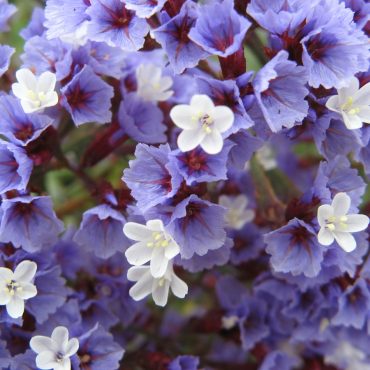There are five different species of sea lavenders at the San Elijo Lagoon Ecological Reserve. They all belong to the genus Limonium, and are often recognized by a papery colored calyx, which is often thought to be the flower itself. However, only California sea lavender (Limonium californicum) is native to California. Perez’s sea lavender (Limonium perezii) is native to the Canary Islands in Spain, but has established as part of our local flora, and is now abundant along the coast and the roadsides of California.
Perez’s Sea Lavender (not native)
Limonium perezii

Other Common Names:
Canarian sea lavender, marsh rosemary, sea foam, sea lavender, statice
Description 2,4,59
Perez’s sea lavender is a 3 ft (1 m) tall herbaceous perennial. It grows from a woody rhizome that holds a basal rosette of thick, leathery, oval to round leaves with wavy margins and long petioles. Leaf blades are 1 1/2 – 6 inches (4 -15 cm) long and 1 – 2 3/4 inches (2.5 – 7 cm) wide and pinnately veined. Blades are tapered little if at all at the base.
From the basal rosette of Perez’s sea lavender arise many branched, cylindrical flowering stems which are topped with domes of flowers in a pattern that gives the plant a bushy appearance. The individual flowers are radial and bisexual, about 3/16 to 1/4 inches (4 – 6 mm) across, with five white lobed petals enclosed at their base by a funnel of papery, purple sepals which are often perceived as the petals. The flowers of Perez’s sea lavender have one pistil with five styles and five stamens with white to light yellow anthers and light yellow pollen.
Perez’s Sea Lavender blooms from March to September and produces one-seeded fruits from early-December to mid-September.



Distribution 2,7,41
Perez’s sea lavender is native to the Canary Islands, a Spanish archipelago located just off the southern coast of Morocco; it has naturalized in coastal California, primarily south of Point Conception, and is now a common component of the local flora at elevations below 330 ft (100 m).
Sea lavenders are found in coastal habitats such as beaches, salt marshes, coastal prairies as well as saline and alkaline areas. Perez’s sea lavender is widely distributed in these types of habitats, but it is also very common along the roadsides of Southern California and in ornamental landscapes.
At the San Elijo Lagoon Ecological Reserve, Perez’s sea lavender is found at the edge of the Harbaugh Seaside Trails and in the West Basin. Plants used to occur along the Pole Road, but diligent removal by Nature Collective volunteers has eliminated them in that area.
Learn more about plant vegetation types here
Classification
Sea lavenders are dicot angiosperms in the leadwort or plumbago family (Plumbaginaceae), which includes about 400 species of annuals or perennial subshrubs or vines, mostly associated with saline soils. However, only two species of this family are native to California, California sea lavender (Limonium californicum) and sea pink (Armeria maritima ssp. californica2).
Plants in the leadwort family are characterized by simple leaves that often bear glands on the surface, and by radially symmetric bisexual flowers, with five petals, five stamens, five styles,23 and five thin and membranous sepals, that may be more colorful and showy than the petals, and remain attached to the fruit until maturity.176
The leadwort family includes some plants of horticultural value, including sea pink, some varieties of Parez’s sea lavender and the common ornamental, plumbago.
There are four other species of sea lavender at the San Elijo Lagoon Ecological Reserve, the native California sea lavender, and the non-native L. sinuatum, L. ramosissimum and L. duriusculum .48
Alternate Scientific Names:
Statice perezii



Ecology
Many species in the Plumbaginaceae family have salt-secreting glands in their leaves, which allow them to survive in saline areas, such as coastal areas and ocean bluffs.176



Human Uses
Some cultivars of sea lavender have become such an economically important floral crop, that in 1998, the sales of these plants approached 3.7 million U.S. dollars, only in California.177 Limonium perezii cv. ‘Blue Seas’ is widely cultivated for fresh and dried arrangements, since their calyces retain their color and remain long after the corollas have fallen.
Perez’s sea lavender has been propagated using saline water of up to 10 dS m-1.178
The family’s Latin name (Plumbaginaceae) is derived from the Latin Plumbum (“lead”), perhaps due to an early belief that one of the members of this family could cure lead poisoning.180



Interesting Facts
Limonium perezii was originally named by the Austrian Botanist Otto Stapf, Statice perezii, in honor to Dr. George V. Perez, who contributed seed of different species of sea lavender to the Kew Royal Botanic Gardens.181 The genus Statice was moved to Limonium in 1916 by Frederic Hubbard.206
Some sea lavenders are among those species considered vulnerable in their native habitat, but when introduced and naturalized in a different area have become invasive and replaced native vegetation. Due to its low number and restricted distribution in the Canary Islands, L. perezii is classified as Vulnerable (VU) on the International Union for Conservation of Nature and Natural Resources (IUCN) Red List.172 However, in California it is considered an ornamental landscape “escapee”, and is now included in the “Watch List” of the California Invasive Plant Council because of its potential to spread in the California wildlands.183, 184




